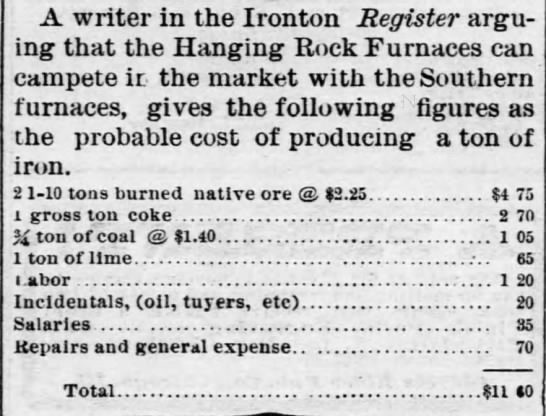Hanging Rock Forge – Hamilton Tp. – The first forge was built in the county in 1830 by James Rodgers and Robert Hamilton. Henry Hanna changed Hanging Rock Forge into a rolling mill in 1840. Another article stated the Forge was built in 1832 by Andrew Ellison, James Rodgers, and Robert Hamilton.
Hanging Rock Iron Forge – Hamilton Tp. – In 1833, John Campbell was employed in building the old Hanging Rock Iron Forge, and in the same year, he, with Andrew Ellison, built Lawrence Furnace for J. Riggs & Co. and took stock in it.
Hanging Rock Foundry – Hamilton Tp. – This was the first foundry built in Lawrence County by Peebles, Wood & Company in 1844. IR Nov. 12, 1885 – This well-known foundry began work under the new company (not named) last Monday and made their first cast Tuesday afternoon…
The Plymouth, B. Estate, Great Western, and other noted stoves will be made there. The first melt was made from Meta iron…Chas. Peters is Supt. and Business Manager; Henry Henderson is foreman; Wm. Halley is Engineer and Cupola tender. Under the new company, Capt. Ben Rodgers caught the first ladle of iron, and his son Frank poured the first ladle.

Ironton Sunday Tribune, February 27, 1927
Old Hanging Rock Furnace Now Only a Relic of Distant Past
One of the landmarks of this section of the country, especially the Hanging Rock neighborhood, is being slowly dismantled and will soon be a memory. The old Hanging Rock blast furnace, which operated until November 1923 continuously from the time of its construction in 1883 by Means, Kyle, and Company, has outlived its usefulness and is being junked. Salvage work to date has removed all possibility of the furnace ever being placed in operation again. It has been announced by Wm. Jefferys, president of the Iron Company owners.
The furnace has fast crumbled away since it was put out of operation in 1923. Recently the heavy steel smoke stacks were pulled down because of their menace to travelers on the A. P. Highway through the village. There was always the danger of their being blown over the road, and officials concerned took the necessary safety steps. The wooden ore trams have fallen down, the casing “shed” wrecked and other equipment removed. The blast furnaces remain intact with other buildings, but indications are that these will soon be razed and the site cleared.
In passing from the operation, the furnace joins other furnace skeletons which remain in Lawrence county as bleak reminders of those turbulent days when this, the heart of the nationally known Hanging Rock Region, was in its prime. The Pine Grove, Vesuvius, Hecla, Oak Ridge, Union, and other older furnaces have passed.
Still, only a few were of the modern blast type at Hecla, Pine Grove, and other points. The heavy stone stoves remain reminders of active days when charcoal furnaces were in vogue and before the new hot blast era in 1837. A hot blast experiment was conducted at old Vesuvius Furnace in 1837 by William Firmstone, the first in the United States, and it revolutionized the industry.
The Hanging Rock Furnace story brings to light other interesting features. In the years of the charcoal business, all iron was brought to Hanging Rock as a river shipping point with no railroads. The H.R. Railroad, the narrow gauge line familiar to all residents of this section of the country, was built for the transportation of coal and iron from Pine Grove to Hanging Rock and the river. That was when the New Castle mines were in full operation, and the road was successful from its start in the 40s. Two by four-inch rails of oak were used, nailed to under supports.
Later flat, wide steel rails raised on one side were used, and some of these may still be found along the mine entrances of the company’s right of way. Later 60-pound charcoal iron rails were installed, and the railroad is still in shape for operation. The small 50-ton engine has been seen by all Hanging Rock residents and is even now put in operation when occasion demands transportation of forest products from the Pine Grove neighborhood. The property is controlled by the New Castle and Ohio River Railway Company. That concern recently filed an application with the Interstate Commerce Commission for permission to abandon the line.
The Hanging Rock Iron Co. has 8000 acres of land between Hanging Rock and Pine Grove, all rich in timber and mineral products. The property is being liquidated, and the capital stock is retired. Soon the concern will be dissolved, and another interesting chapter in the history of Ironton and this section of the country will conclude.

0 Comments